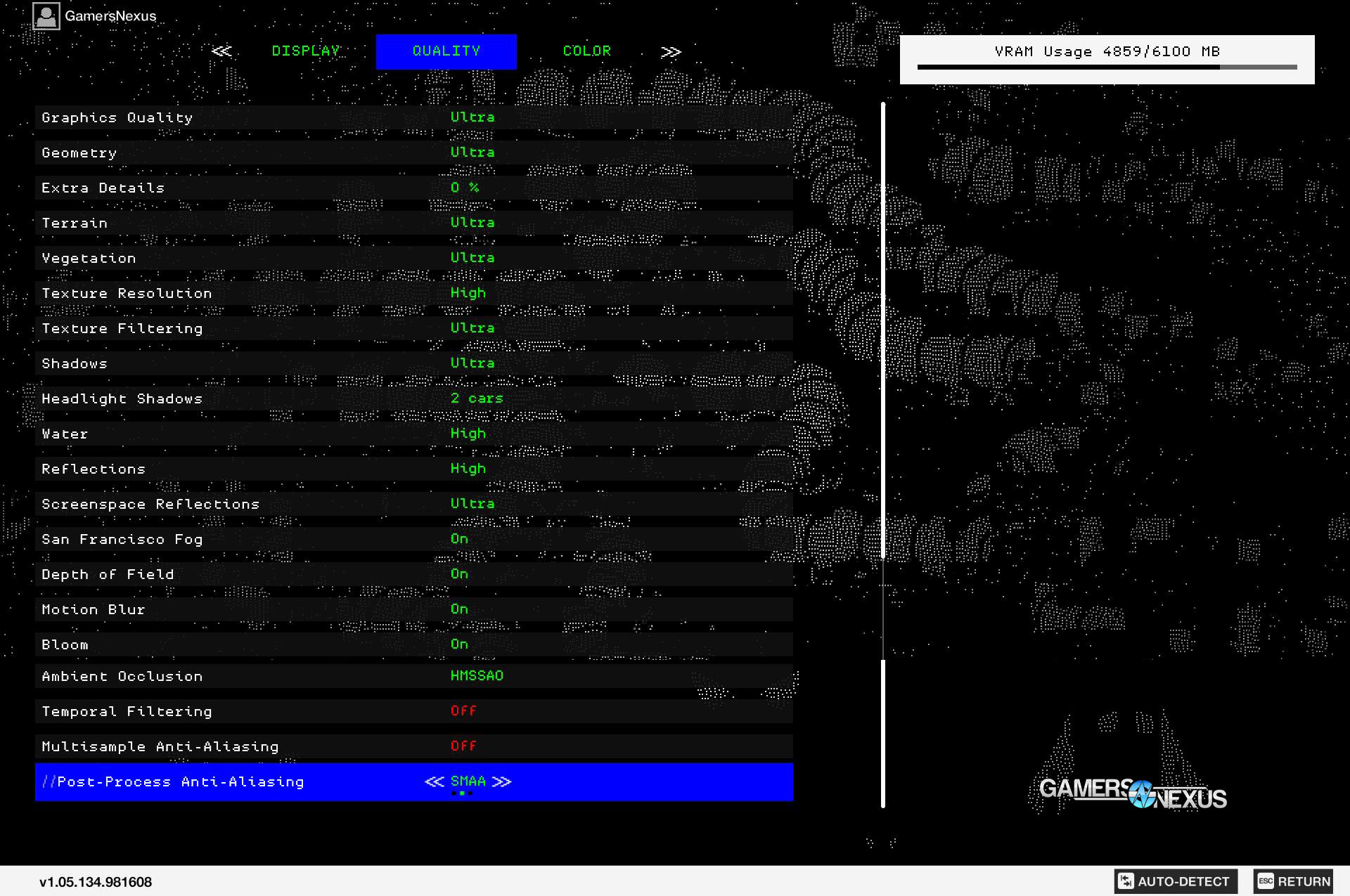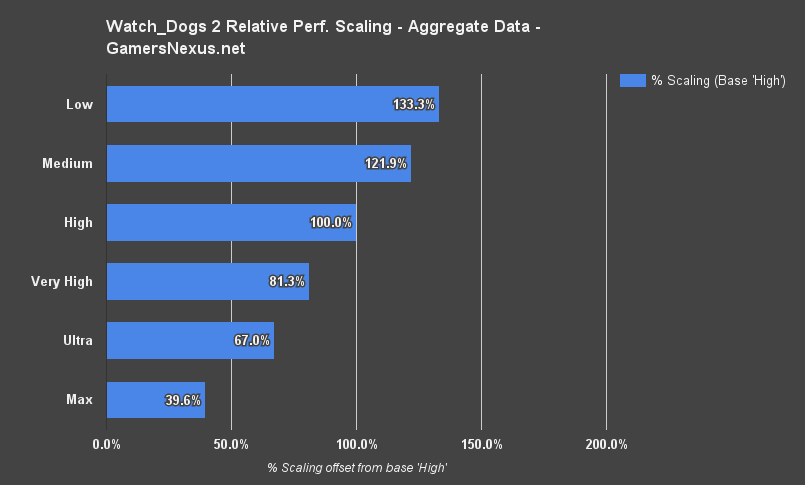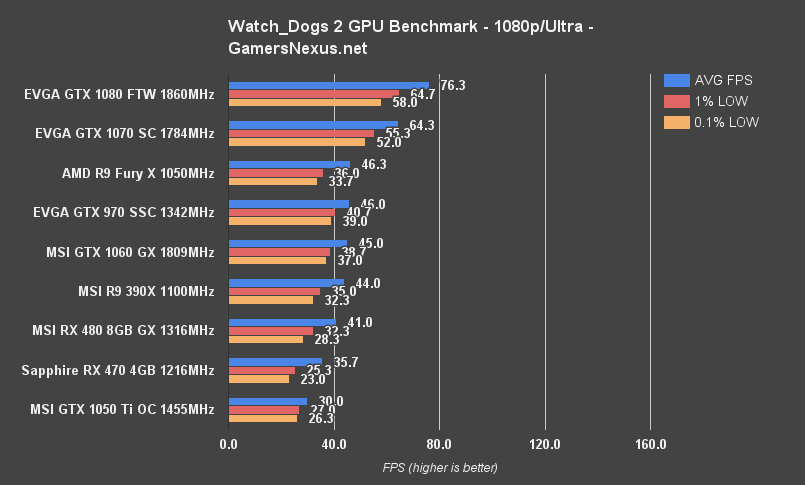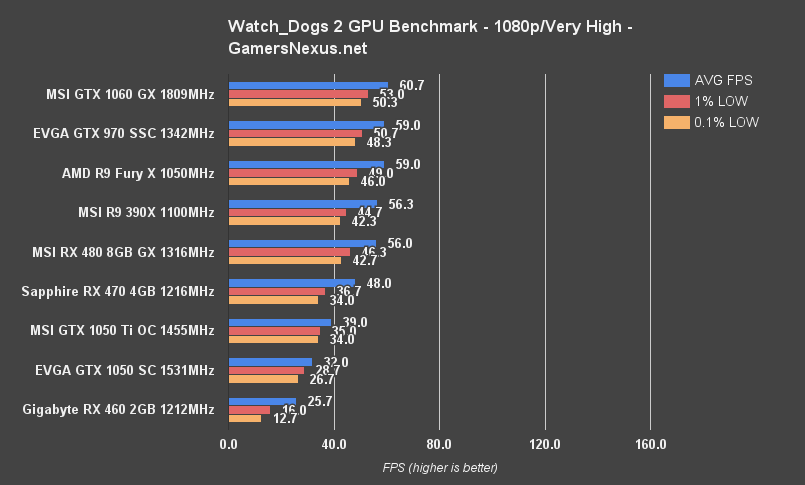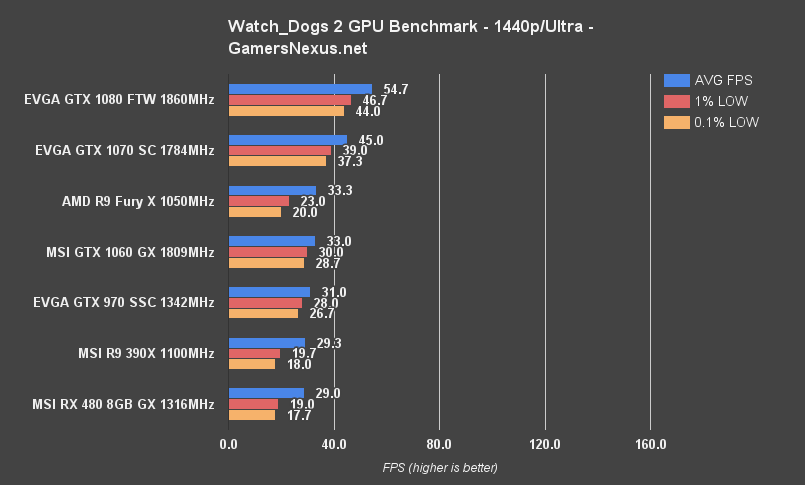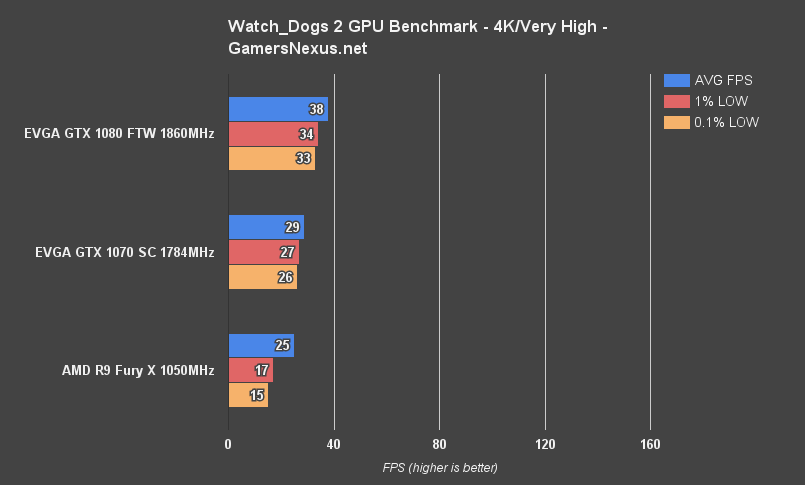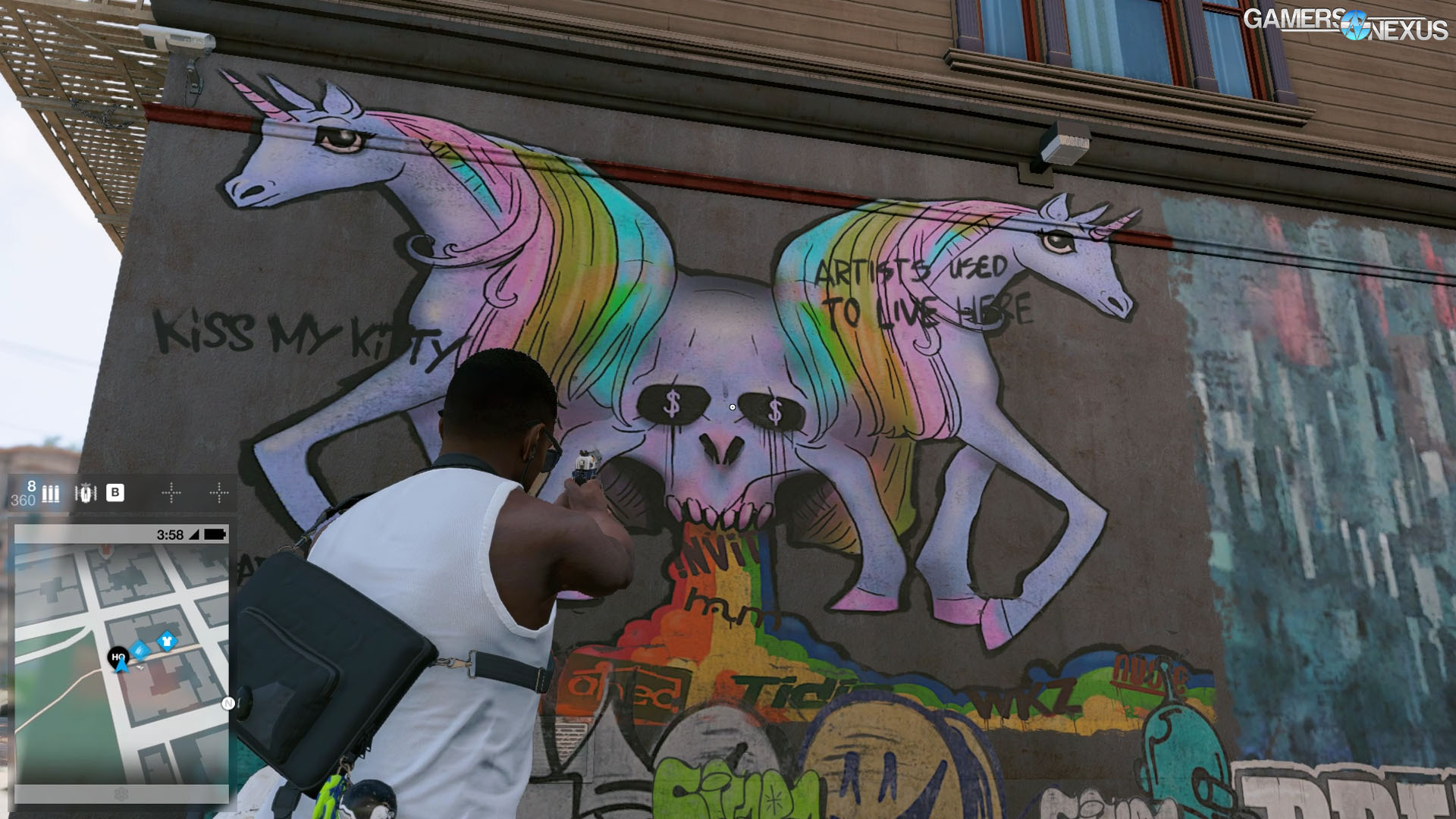Ubisoft's newest dystopian efforts start strong with allusions to modern-day challenges pertaining to privacy and "cyber warfare," working to build-up our character as a counter-culture hacker. And, as with Ubisoft's other AAA titles, the game builds this world with high-resolution textures, geometrically complex and dense objects, taxing shadow/lighting systems, and an emphasis on graphics quality.
Watch Dogs 2 is a demanding title to run on modern hardware. We spent the first 1-2 hours of our time in Watch Dogs 2 simply studying the impact of various settings on performance, further studying locales and their performance hits. Areas with grass and foliage, we found, most heavily hit framerate. Nightfall or dark rain play a role in FPS hits, too, particularly when running high reflection qualities and headlight shadows.
We look at performance of 11 GPUs in this Watch Dogs 2 video card benchmark, including the RX 480 vs. GTX 1060, GTX 1070, GTX 1080, RX 470, R9 Fury X, and more.
Watch Dogs 2 Graphics Settings Defined
The above screenshot shows the entirety of Watch Dogs 2's graphics settings, as exposed through the in-game user interface with version 1.05.134.981608.
Graphics Quality: A preset used to rapidly define the following settings.
Geometry: Density of primitives / overall "smoothness" of objects and models within the game. Affects geometric complexity and mesh quality.
Extra Details: Adds definition to geometry in game, including meshes (more smoothing, finer detail on vehicles, etc.). Sets 0-100%. This does not get applied with any of the presets and must be manually configured.
Terrain: LOD scaling of terrain. Detail, definition, and smoothness of terrain as it grows distant from the player POV.
Vegetation: LOD scaling of foliage, with additional impact to object complexity for certain vegetation elements (like high-detail tree models). Impacts how dense the foliage appears.
Texture Resolution: With the base game, without texture DLC, this can be configured to Low, Medium, and High. Texture resolution changes necessitate a game restart to adequately apply. Texture resolution impacts the pixel density and apparent grit in (obviously) object textures.
Shadows: Can be configured to Low, Medium, High, Very High, Ultra, or PCSS (Percentage Closer Soft Shadows), or HFTS (High-Fidelity Frustum-Traced Shadows). We previously defined HFTS in depth here.
Headlight Shadows: Maximum number of vehicles that will cast headlight shadows. This becomes performance intensive when it's dark, rainy, and heavily populated.
Screenspace Reflections: Pixels are depth-sampled and crunched to determine screen space-aware reflections, e.g. within puddles that appear during rain. If experiencing lag when it rains in Watch Dogs 2, try lowering this setting and the headlight shadows setting.
San Francisco Fog: Rolling fog that limits visibility, but appears voluminous.
Depth of Field: Bokeh effect application/intensity when shifting focus to different objects.
Bloom: "Shimmering" effect for light when in hot environments or near bodies of water.
Ambient Occlusion: SSBC and HMSSAO modify the accuracy, depth, and presence of shadows created at points of contact between surfaces.
Temporal Filtering: Frame-to-frame calculation of filters, rather than calculating all at once. Improves performance.
Post-Process Anti-Aliasing: Simplistic anti-aliasing with limited impact to FPS. This is best known for FXAA, the most common implementation of Post-Process AA.
Watch Dogs 2 Video Card Benchmark & Gameplay
Test Methodology
We tested using our GPU test bench, detailed in the table below. Our thanks to supporting hardware vendors for supplying some of the test components.
Drivers built for Watch Dogs 2 were used on all AMD and nVidia devices. This includes driver kit 16.11.5 for AMD and kit 376.09 for nVidia.
| GN Test Bench 2015 | Name | Courtesy Of | Cost |
| Video Card | This is what we're testing! | - | - |
| CPU | Intel i7-5930K CPU 3.8GHz | iBUYPOWER | $580 |
| Memory | Corsair Dominator 32GB 3200MHz | Corsair | $210 |
| Motherboard | EVGA X99 Classified | GamersNexus | $365 |
| Power Supply | NZXT 1200W HALE90 V2 | NZXT | $300 |
| SSD | HyperX Savage SSD | Kingston Tech. | $130 |
| Case | Top Deck Tech Station | GamersNexus | $250 |
| CPU Cooler | NZXT Kraken X41 CLC | NZXT | $110 |
Game settings were manually controlled for the DUT. All games were run at presets defined in their respective charts. Our test courses are all manually conducted. In the case of our bulk data below, the same, easily repeatable test was conducted a minimum of three times per device, per setting. This ensures data integrity and helps to eliminate potential outliers. In the event of a performance anomaly, we conduct additional test passes until we understand what's going on. In NVIDIA's control panel, we disable G-Sync for testing (and disable FreeSync for AMD, where relevant). Note that these results were all done with the newest drivers, including the newest game patches, and may not be comparable to previous test results for the same game. Also note that tests between different review outlets should not necessarily be directly compared as testing methodology may be different. Just the measurement tool alone can have major impact.
We measure using the onPresent variable, not onDisplay. Make sure you understand what you're comparing results to if doing so, and also ensure that the same tools are used for analysis. A frame does not necessarily equal a frame between software packages. Our team has built a custom, in-house Python script to extract average FPS, 1% low FPS, and 0.1% low FPS data (effectively 99/99.9 percentile metrics). The test pass is executed for 30 seconds per repetition, with a minimum of 3 repetitions. This ensures an easily replicated test course for accurate results between cards, vendors, and settings. You may learn about our 1% low and 0.1% low testing methodology here:
Windows 10-64 Anniversary Edition was used for the OS.
Partner cards were used where available and tested for out-of-box performance. Frequencies listed are advertised clock-rates.
We'll be looking at the game with 1080p Ultra, Very High, Medium, 1440p Ultra, and 4K Very High. The game was tested near Mission Park, where we mix in cars, grass, and complex trees. We carefully tested at exactly the same time of day, with the same conditions. A sunny day casts more shade from the foliage, which more heavily impacts performance. V-Sync is always disabled.
Performance Scaling in Watch Dogs 2
This first chart demonstrates relative performance scaling using aggregate sampling among mid-range cards. This is not a perfect method for determining scaling between quality settings, but provides a baseline. A lower-end device, like a GTX 960 2GB or 1050 2GB, would not see identical scaling to the above (the high-quality performance would be hit much more heavily).
The "Max" setting above is the Ultra preset + 100% "Extra Detail" and HFTS enabled.
Watch Dogs 2 Benchmark (1080p, Ultra): GTX 1080 vs. GTX 1070, Fury X, R9 390X
EVGA's GTX 1080 FTW ($680) unsurprisingly leads the pack, operating this configuration at about 76FPS AVG, with lows consistently around 60FPS. The GTX 1070, a card around roughly $400, is capable of juggling 1080p at Ultra settings with a 64FPS throughput and close-behind lows.
AMD's R9 Fury X pushes a framerate comparable to the 970 SSC, not benefiting noticeably from its HBM. That's not the first time we've seen this performance between the 970 SSC and Fury X.
Moving down to the mid-range cards, we're seeing MSI's GTX 1060 Gaming X ($310) operating at 45FPS AVG, about 39FPS 1% low, and 37FPS 0.1% lows. That's fairly tightly timed across the board, and remains reasonably playable. We'll look at how Very High supports the 1060 in a moment, though. For folks on the GTX 970, as shown here, you'll be at roughly equal performance to a GTX 1060.
Moving to MSI's Gaming X version of the RX 480 8GB ($278), the card is producing an AVG FPS of about 41, with lows at 32 and 28FPS, respectively. Our gaps between averages and lows are a bit larger than on the GTX 1060 here, though the visible difference is not necessarily substantial at this point.
Next, the RX 470 4GB pushes a 35.7FPS AVG, with 0.1% lows also somewhat distantly timed. This card begins to exhibit some stuttering during play, a result of frametime disparity.
Watch Dogs 2 Benchmark (1080p, Very High): GTX 1060 vs. RX 480, GTX 1070, RX 470, 970
Our Very High charts are a little simplified. The high-end devices remain on the Ultra test charts. At the top of this particular chart, we see the GTX 1060 Gaming X and GTX 970 SSC both at roughly 60FPS AVG. The RX 480 Gaming X follows this, at 56FPS AVG and effectively equal to the GTX 970 in performance. The difference between the RX 480 Gaming X and GTX 1060 Gaming X is largely insignificant.
The new cards on this chart include the GTX 1050 2GB ($120) and RX 460 2GB. The 1050 non-Ti card is pushing a 32FPS AVG, with sort of rough lows. The RX 460 is in similar shape, though worse off at 26FPS AVG and 13FPS 0.1% lows. This manifests itself noticeably in jarring stutters.
Just for a quick reference, we ran the 1050 2GB and 460 2GB at Medium settings for a more realistic look at performance. The result was an output of about 51FPS AVG for the 1050, and 44FPS AVG for the RX 460 -- though the lows still struggle.
Watch Dogs 2 Benchmark (1440p, Ultra): GTX 1080, GTX 1070, RX 480, R9 390X
1440p/Ultra is a bit taxing, but we gave it a shot. The GTX 1080 FTW pushes about 55FPS AVG, with lows consistently north of 40FPS. Next, the 1070 runs a 45FPS AVG and remains fairly playable with how Watch Dogs 2 is built. The GTX 1060, Fury X, GTX 970, and down all enter into stutter range, and would be better matched to 1440p with a settings reduction to High.
Watch Dogs 2 Benchmark (4K, Very High): GTX 1080 FTW, Fury X, GTX 1070 SC
Given Watch Dogs' intensive settings, we only tested 3 cards with 4K resolution. The GTX 1080 FTW isn't quite 4K-ready at Very High settings, but could do it with a settings reduction. The 1070 SC would need to be dropped closer to a mix of high settings for FPS in the 40s. The Fury X isn't much of a contender, here, and stutters like mad with those low framerates.
Best Video Cards for Watch Dogs 2
Watch Dogs 2 is an abusive game on hardware. The shadow and lighting complexity alone makes for lower framerates at 1080p than might be expected of high-end hardware, and that's reinforced when screen-space aware reflections come into play.
Fortunately, for all of its intensity, Watch Dogs 2 is also not as demanding of a high framerate as some more competitive titles. We found Watch Dogs 2 to be generally "playable" (without immersion-breaking stutters) within a range of ~40~45FPS AVG. This isn't a game that demands 60FPS for a good time; you'll get by just fine sub-60, though much lower than 40-45 and it does become a bit of a stutter-fest.
Frametimes are consistent across the board, sans 2GB devices when tested with medium to high texture resolutions.
If considering "Very High" to be an acceptable graphics quality setting at 1080p -- and it is fairly similar in appearance to Ultra -- we'd point you toward the GTX 970 and up from nVidia (GTX 1060, or 1070 for Ultra) or RX 470 and up from AMD.
The GTX 1060 and RX 480 can output 1080p/Ultra in the 40s. A GTX 1070 sits in the 60s.
Higher resolutions are pretty rough. A GTX 1080 FTW struggled with 4K at Very High. You'd ideally want a mix closer to high/very high for quality settings at 4K. A 1070 would require a harder drop, e.g. medium-high.
It's not an easy game to run. The shadows and lighting are a testament to the visual fidelity, and the framerates are a testament to just how heavily the game taxes these cards.
Editorial, Video: Steve "Lelldorianx" Burke
Test Lead: Andie "Draguelian" Burke
